
The LeVeque Tower is a 47-story skyscraper in Downtown Columbus, Ohio. At 555 feet 5 inches (169.29 m) it was the tallest building in the city from its completion in 1927 to 1974, and remains the second-tallest today.
The Near East Side is a neighborhood located near downtown Columbus, Ohio, made up of several neighborhoods: Mount Vernon, King-Lincoln Bronzeville, Eastgate, Franklin Park, Nelson Park, Olde Towne East, and Woodland Park.

Riverside Methodist Hospital is the largest member hospital of OhioHealth, a not-for-profit, faith-based healthcare system located in Columbus, Ohio.
Lincoln Goodale was the first doctor to live in Columbus, Ohio, United States. He was a great benefactor to the city and his legacy includes a large parcel of land that today is known as Goodale Park. His likeness in the form of a large bronze bust watches over the park.

Goodale Park is a public park in the Victorian Village area of Columbus, Ohio. It was donated to the city in 1851 by Lincoln Goodale. For a few months during the Civil War, it was a staging area for Union troops known as Camp Jackson. ComFest, a large, free, multi-day, non-corporate, music and arts annual festival, is held in the park in June.
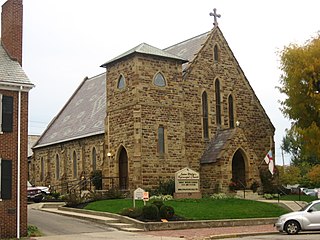
Howell & Thomas was an American architectural partnership formed by Carl Eugene Howell (1879–1930) and James William Thomas, Jr. (1876–1973) in Columbus, Ohio, and later, Cleveland, Ohio, that designed many residences for wealthy clients between 1908 and 1930. The partners were classmates at University of Pennsylvania and first established their practice in Columbus, Ohio. They designed homes for the Euclid Golf subdivision along Fairmont Boulevard in Cleveland Heights, built on the site of John D. Rockefeller's once private course.
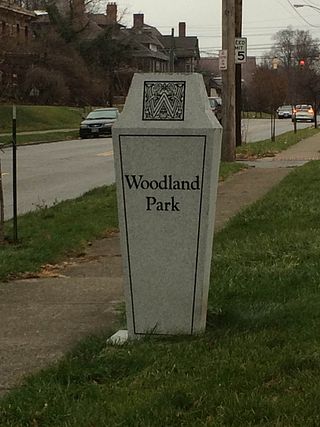
Woodland Park is a residential neighborhood located in the Near East Side of Columbus, Ohio that houses approximately 1,500 residents. The neighborhood was previously home to such figures as artist Emerson Burkhart, cartoonist Billy Ireland, and judge William Brooks. Established in the early 20th century, Woodland Park has grown from its planned neighborhood roots into a neighborhood that contains various faith communities, schools, sources of entertainment and recreation, and borders an extension of the Ohio State University medical center.

Trinity Episcopal Church is a historic church on Capitol Square in Downtown Columbus, Ohio. It was built in 1866 and added to the National Register of Historic Places in 1976.

Schiller Park is a 23.45-acre (9.49 ha) municipal park located in German Village, a historic neighborhood in Columbus, Ohio. The park is bounded by Reinhard Avenue to the north, Jaeger Street to the east, East Deshler Avenue to the south, and City Park Avenue to the west.
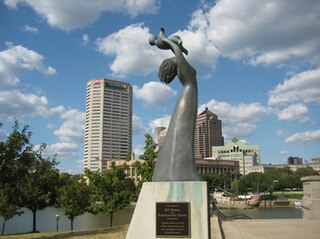
Celebration of Life, also known as the Arthur Boke/Sarah Sullivan statue, is a 2004 bronze sculpture by Alfred Tibor, installed near Franklinton's Genoa Park, in Columbus, Ohio, United States. The artwork depicts a woman holding a baby above her head, and commemorates Arthur Boke, the first known black child born in Franklinton, and Sarah Sullivant, the wife of Lucas Sullivant. The Sullivants, a white couple, raised Boke as their own child.
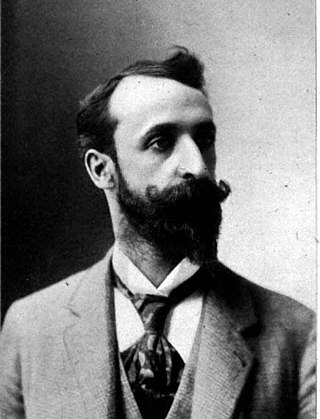
Herbert A. Linthwaite was an American architect and a member of the AIA Columbus. Born in Indiana, Linthwaite rose to prominence as an architect in Columbus, Ohio from 1879 to 1911, when he moved to Los Angeles. In 1922, he built the Garber House; it became a Los Angeles Historic-Cultural Monument in 2007. He married Sara De Long in September 1879 and died in Los Angeles in 1929.
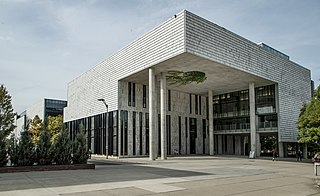
The architecture of Columbus, Ohio is represented by numerous notable architects' works, individually notable buildings, and a wide range of styles. Yost & Packard, the most prolific architects for much of the city's history, gave the city much of its eclectic and playful designs at a time when architecture tended to be busy and vibrant.
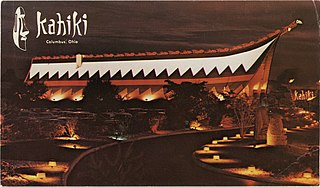
The Kahiki Supper Club was a Polynesian-themed restaurant in Columbus, Ohio. The supper club was one of the largest tiki-themed restaurants in the United States, and for a time, the only one in Ohio. It operated at its Eastmoor location on Broad Street beginning in 1961, at the height of tiki culture's popularity. The Kahiki was listed on the National Register of Historic Places in 1997, but closed and was demolished in 2000. It was described as an exceptionally important example of a themed restaurant and the most elaborate tiki restaurant ever built.
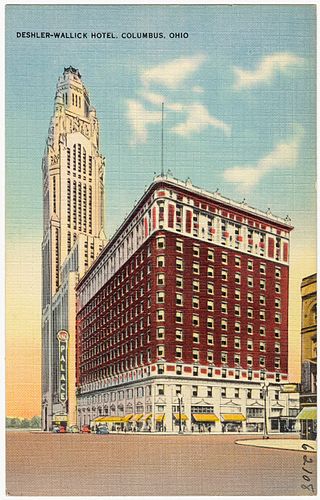
The Deshler Hotel, also known as the Deshler-Wallick Hotel, was a hotel building in Downtown Columbus, Ohio. The hotel was located at Broad and High Streets, the city's 100 percent corner.

The Old Franklinton Cemetery is a cemetery in the Franklinton neighborhood of Columbus, Ohio. The cemetery is the oldest in Central Ohio, established in 1799. Other names for it include the Franklinton Cemetery or Pioneer Burying Ground. Franklinton founder Lucas Sullivant was buried there initially, later reinterred in Green Lawn Cemetery.
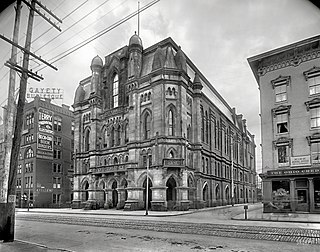
Columbus City Hall was the city hall for Columbus, Ohio, located on Capitol Square in the city's downtown. The building served the mayor and city council from its construction in 1872 until its demolition in 1921. The building was the founding site for the United Mine Workers of America in 1890. In 1928, the site became home to the Ohio Theatre, and the current Columbus City Hall opened nearby.

The Columbus Board of Trade Building was a historic building on Capitol Square in Downtown Columbus, Ohio. The building was built in 1889 for the present-day Columbus Chamber of Commerce, and was designed by Elah Terrell and Joseph W. Yost. It became vacant in 1964 and was demolished five years later. The Rhodes State Office Tower sits on the site today.
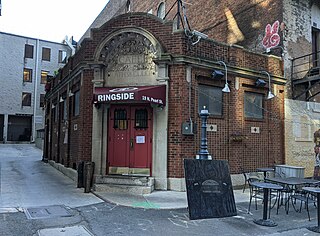
Ringside Café is a restaurant and bar in Downtown Columbus, Ohio. The restaurant is considered the oldest bar or restaurant in Downtown Columbus, having opened in 1897 and operated continuously since then. The restaurant has always been an attraction of politicians, lawyers, reporters, and lobbyists, given its proximity to the Ohio Statehouse, Columbus City Hall, and other government buildings.

The Hartman Building and Theater was a pair of historic buildings on Capitol Square in Downtown Columbus, Ohio. The structures were commissioned by Samuel B. Hartman, designed by Richards, McCarty and Bulford in the Renaissance Revival style. The theater was demolished in 1971, followed by the office building in 1981.

















